University Report: Female Genital Mutilation in the UK Analysis
VerifiedAdded on 2021/04/21
|23
|4653
|132
Report
AI Summary
This report presents a comprehensive study on Female Genital Mutilation (FGM) in the United Kingdom. It begins with an introduction to FGM, including its definition, prevalence, and legal status in the UK. The report explores the research title, questions, aims, and objectives, along with background information and justification for the research. The methodology section details the research philosophy (Interpretivism), approach (Inductive), and method (Descriptive), including data collection methods using questionnaires and interviews, and sampling techniques. Ethical considerations related to FGM are also discussed. The report further outlines key research participants, interview themes, a literature search strategy, and a research timetable. The study examines the current state of FGM in the UK, reasons for conducting the research, and potential areas for future exploration. The report concludes with a summary of findings and a bibliography of cited sources, providing a thorough examination of the issue of FGM in the UK. The document is available on Desklib, a platform providing study resources.
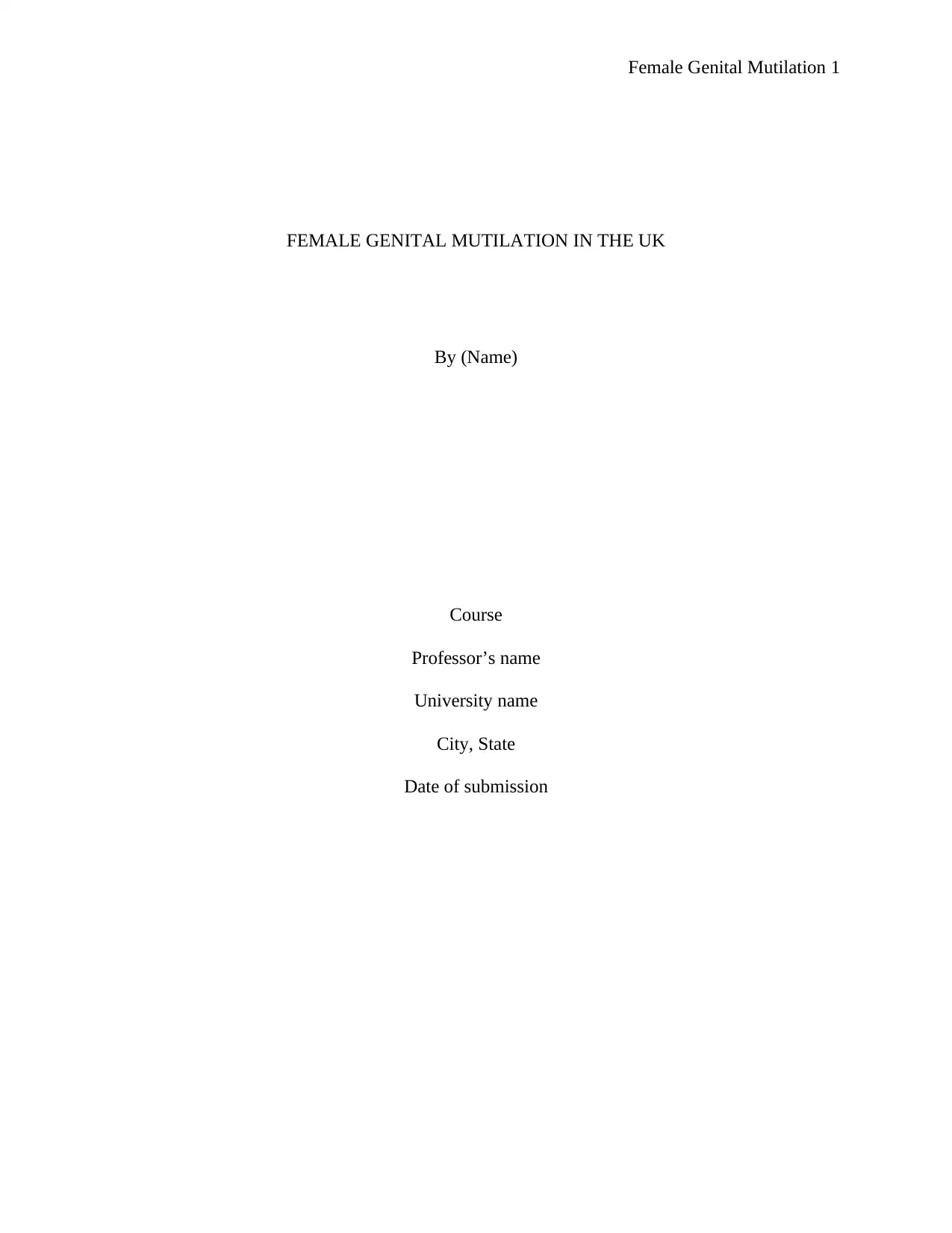
Female Genital Mutilation 1
FEMALE GENITAL MUTILATION IN THE UK
By (Name)
Course
Professor’s name
University name
City, State
Date of submission
FEMALE GENITAL MUTILATION IN THE UK
By (Name)
Course
Professor’s name
University name
City, State
Date of submission
Paraphrase This Document
Need a fresh take? Get an instant paraphrase of this document with our AI Paraphraser
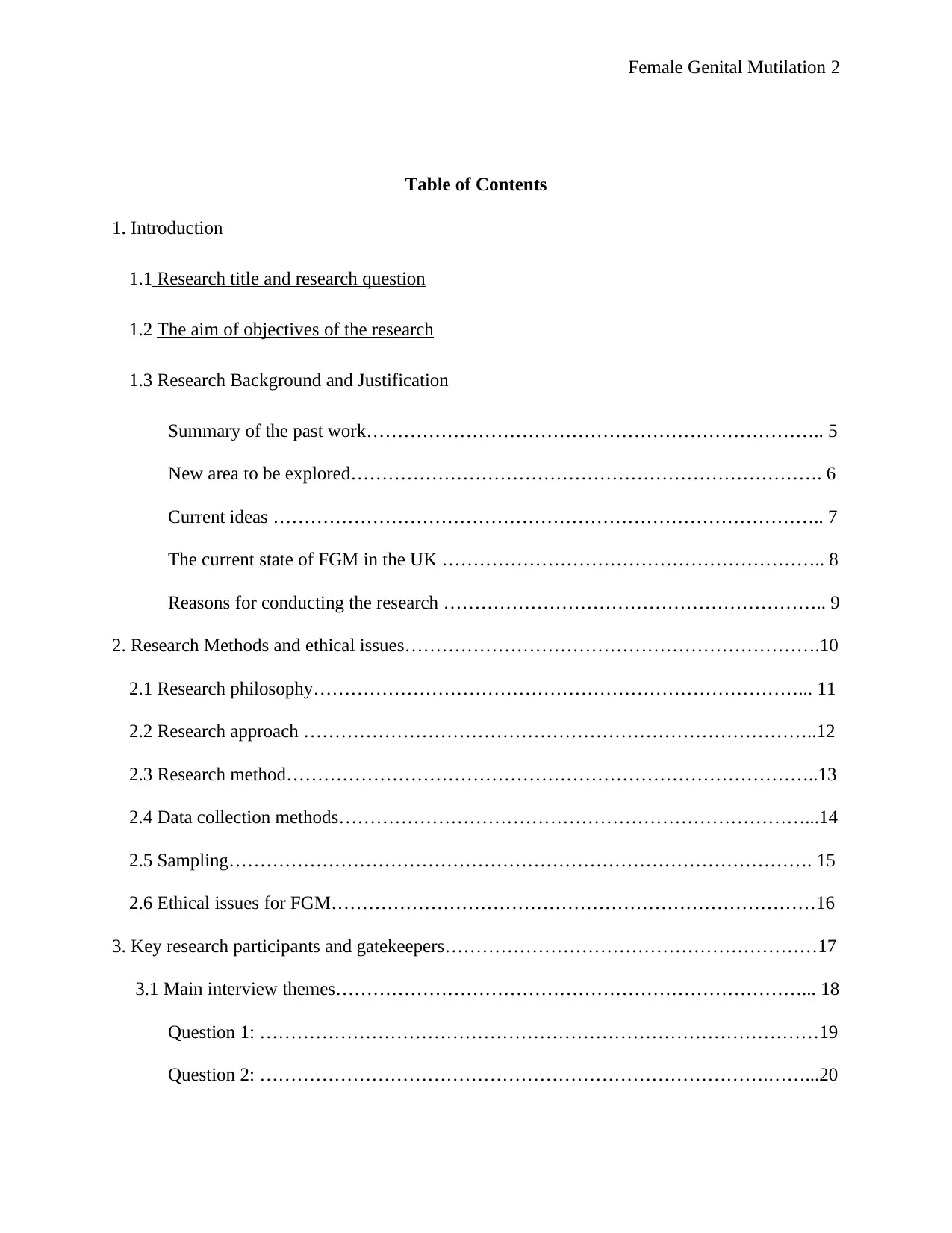
Female Genital Mutilation 2
Table of Contents
1. Introduction
1.1 Research title and research question
1.2 The aim of objectives of the research
1.3 Research Background and Justification
Summary of the past work……………………………………………………………….. 5
New area to be explored…………………………………………………………………. 6
Current ideas …………………………………………………………………………….. 7
The current state of FGM in the UK …………………………………………………….. 8
Reasons for conducting the research …………………………………………………….. 9
2. Research Methods and ethical issues………………………………………………………….10
2.1 Research philosophy……………………………………………………………………... 11
2.2 Research approach ………………………………………………………………………..12
2.3 Research method…………………………………………………………………………..13
2.4 Data collection methods…………………………………………………………………...14
2.5 Sampling…………………………………………………………………………………. 15
2.6 Ethical issues for FGM……………………………………………………………………16
3. Key research participants and gatekeepers……………………………………………………17
3.1 Main interview themes…………………………………………………………………... 18
Question 1: ………………………………………………………………………………19
Question 2: ……………………………………………………………………….……...20
Table of Contents
1. Introduction
1.1 Research title and research question
1.2 The aim of objectives of the research
1.3 Research Background and Justification
Summary of the past work……………………………………………………………….. 5
New area to be explored…………………………………………………………………. 6
Current ideas …………………………………………………………………………….. 7
The current state of FGM in the UK …………………………………………………….. 8
Reasons for conducting the research …………………………………………………….. 9
2. Research Methods and ethical issues………………………………………………………….10
2.1 Research philosophy……………………………………………………………………... 11
2.2 Research approach ………………………………………………………………………..12
2.3 Research method…………………………………………………………………………..13
2.4 Data collection methods…………………………………………………………………...14
2.5 Sampling…………………………………………………………………………………. 15
2.6 Ethical issues for FGM……………………………………………………………………16
3. Key research participants and gatekeepers……………………………………………………17
3.1 Main interview themes…………………………………………………………………... 18
Question 1: ………………………………………………………………………………19
Question 2: ……………………………………………………………………….……...20

Female Genital Mutilation 3
Question 3: ………………………………………………………………………………21
Question 4: ………………………………………………………………………………22
Question 5: ………………………………………………………………………………23
4 Literature search strategy and Key literature of FGM in UK ……………………………........24
5 Research timetable ……………………………………………………………………….........25
6 Conclusion ……………………………………………………………………………………26
7 Bibliography ………………………………………………………………………………… 27
Question 3: ………………………………………………………………………………21
Question 4: ………………………………………………………………………………22
Question 5: ………………………………………………………………………………23
4 Literature search strategy and Key literature of FGM in UK ……………………………........24
5 Research timetable ……………………………………………………………………….........25
6 Conclusion ……………………………………………………………………………………26
7 Bibliography ………………………………………………………………………………… 27
⊘ This is a preview!⊘
Do you want full access?
Subscribe today to unlock all pages.

Trusted by 1+ million students worldwide
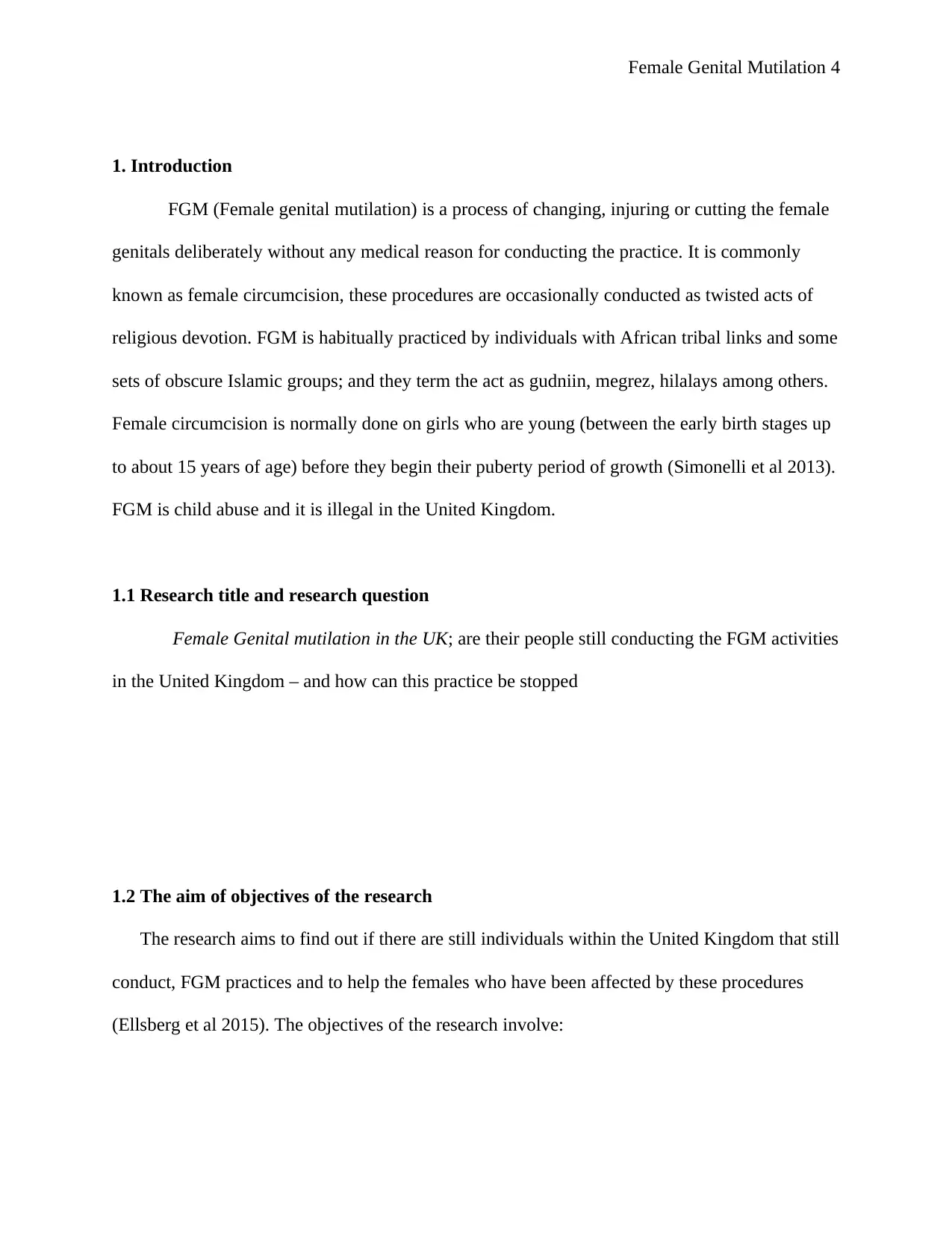
Female Genital Mutilation 4
1. Introduction
FGM (Female genital mutilation) is a process of changing, injuring or cutting the female
genitals deliberately without any medical reason for conducting the practice. It is commonly
known as female circumcision, these procedures are occasionally conducted as twisted acts of
religious devotion. FGM is habitually practiced by individuals with African tribal links and some
sets of obscure Islamic groups; and they term the act as gudniin, megrez, hilalays among others.
Female circumcision is normally done on girls who are young (between the early birth stages up
to about 15 years of age) before they begin their puberty period of growth (Simonelli et al 2013).
FGM is child abuse and it is illegal in the United Kingdom.
1.1 Research title and research question
Female Genital mutilation in the UK; are their people still conducting the FGM activities
in the United Kingdom – and how can this practice be stopped
1.2 The aim of objectives of the research
The research aims to find out if there are still individuals within the United Kingdom that still
conduct, FGM practices and to help the females who have been affected by these procedures
(Ellsberg et al 2015). The objectives of the research involve:
1. Introduction
FGM (Female genital mutilation) is a process of changing, injuring or cutting the female
genitals deliberately without any medical reason for conducting the practice. It is commonly
known as female circumcision, these procedures are occasionally conducted as twisted acts of
religious devotion. FGM is habitually practiced by individuals with African tribal links and some
sets of obscure Islamic groups; and they term the act as gudniin, megrez, hilalays among others.
Female circumcision is normally done on girls who are young (between the early birth stages up
to about 15 years of age) before they begin their puberty period of growth (Simonelli et al 2013).
FGM is child abuse and it is illegal in the United Kingdom.
1.1 Research title and research question
Female Genital mutilation in the UK; are their people still conducting the FGM activities
in the United Kingdom – and how can this practice be stopped
1.2 The aim of objectives of the research
The research aims to find out if there are still individuals within the United Kingdom that still
conduct, FGM practices and to help the females who have been affected by these procedures
(Ellsberg et al 2015). The objectives of the research involve:
Paraphrase This Document
Need a fresh take? Get an instant paraphrase of this document with our AI Paraphraser
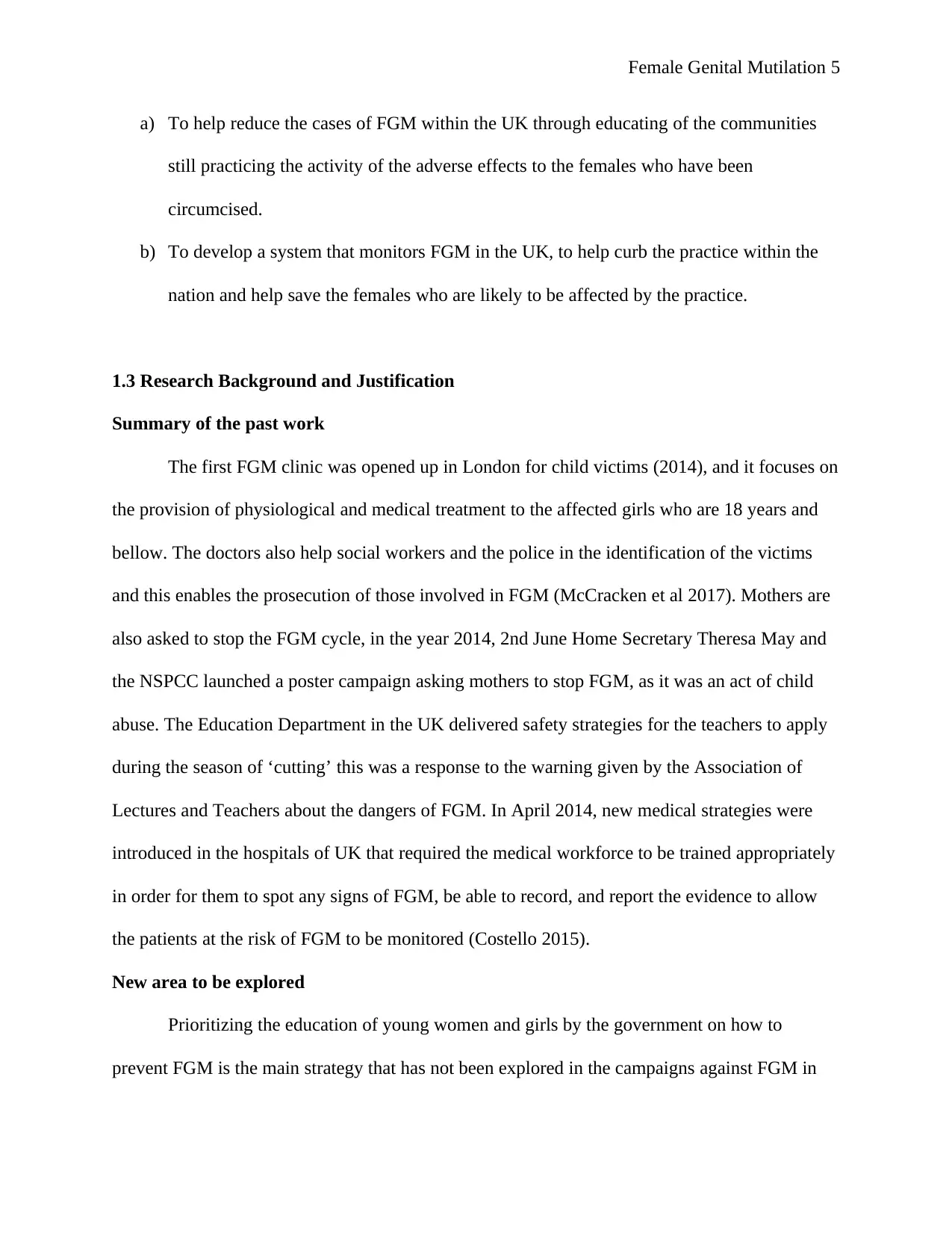
Female Genital Mutilation 5
a) To help reduce the cases of FGM within the UK through educating of the communities
still practicing the activity of the adverse effects to the females who have been
circumcised.
b) To develop a system that monitors FGM in the UK, to help curb the practice within the
nation and help save the females who are likely to be affected by the practice.
1.3 Research Background and Justification
Summary of the past work
The first FGM clinic was opened up in London for child victims (2014), and it focuses on
the provision of physiological and medical treatment to the affected girls who are 18 years and
bellow. The doctors also help social workers and the police in the identification of the victims
and this enables the prosecution of those involved in FGM (McCracken et al 2017). Mothers are
also asked to stop the FGM cycle, in the year 2014, 2nd June Home Secretary Theresa May and
the NSPCC launched a poster campaign asking mothers to stop FGM, as it was an act of child
abuse. The Education Department in the UK delivered safety strategies for the teachers to apply
during the season of ‘cutting’ this was a response to the warning given by the Association of
Lectures and Teachers about the dangers of FGM. In April 2014, new medical strategies were
introduced in the hospitals of UK that required the medical workforce to be trained appropriately
in order for them to spot any signs of FGM, be able to record, and report the evidence to allow
the patients at the risk of FGM to be monitored (Costello 2015).
New area to be explored
Prioritizing the education of young women and girls by the government on how to
prevent FGM is the main strategy that has not been explored in the campaigns against FGM in
a) To help reduce the cases of FGM within the UK through educating of the communities
still practicing the activity of the adverse effects to the females who have been
circumcised.
b) To develop a system that monitors FGM in the UK, to help curb the practice within the
nation and help save the females who are likely to be affected by the practice.
1.3 Research Background and Justification
Summary of the past work
The first FGM clinic was opened up in London for child victims (2014), and it focuses on
the provision of physiological and medical treatment to the affected girls who are 18 years and
bellow. The doctors also help social workers and the police in the identification of the victims
and this enables the prosecution of those involved in FGM (McCracken et al 2017). Mothers are
also asked to stop the FGM cycle, in the year 2014, 2nd June Home Secretary Theresa May and
the NSPCC launched a poster campaign asking mothers to stop FGM, as it was an act of child
abuse. The Education Department in the UK delivered safety strategies for the teachers to apply
during the season of ‘cutting’ this was a response to the warning given by the Association of
Lectures and Teachers about the dangers of FGM. In April 2014, new medical strategies were
introduced in the hospitals of UK that required the medical workforce to be trained appropriately
in order for them to spot any signs of FGM, be able to record, and report the evidence to allow
the patients at the risk of FGM to be monitored (Costello 2015).
New area to be explored
Prioritizing the education of young women and girls by the government on how to
prevent FGM is the main strategy that has not been explored in the campaigns against FGM in
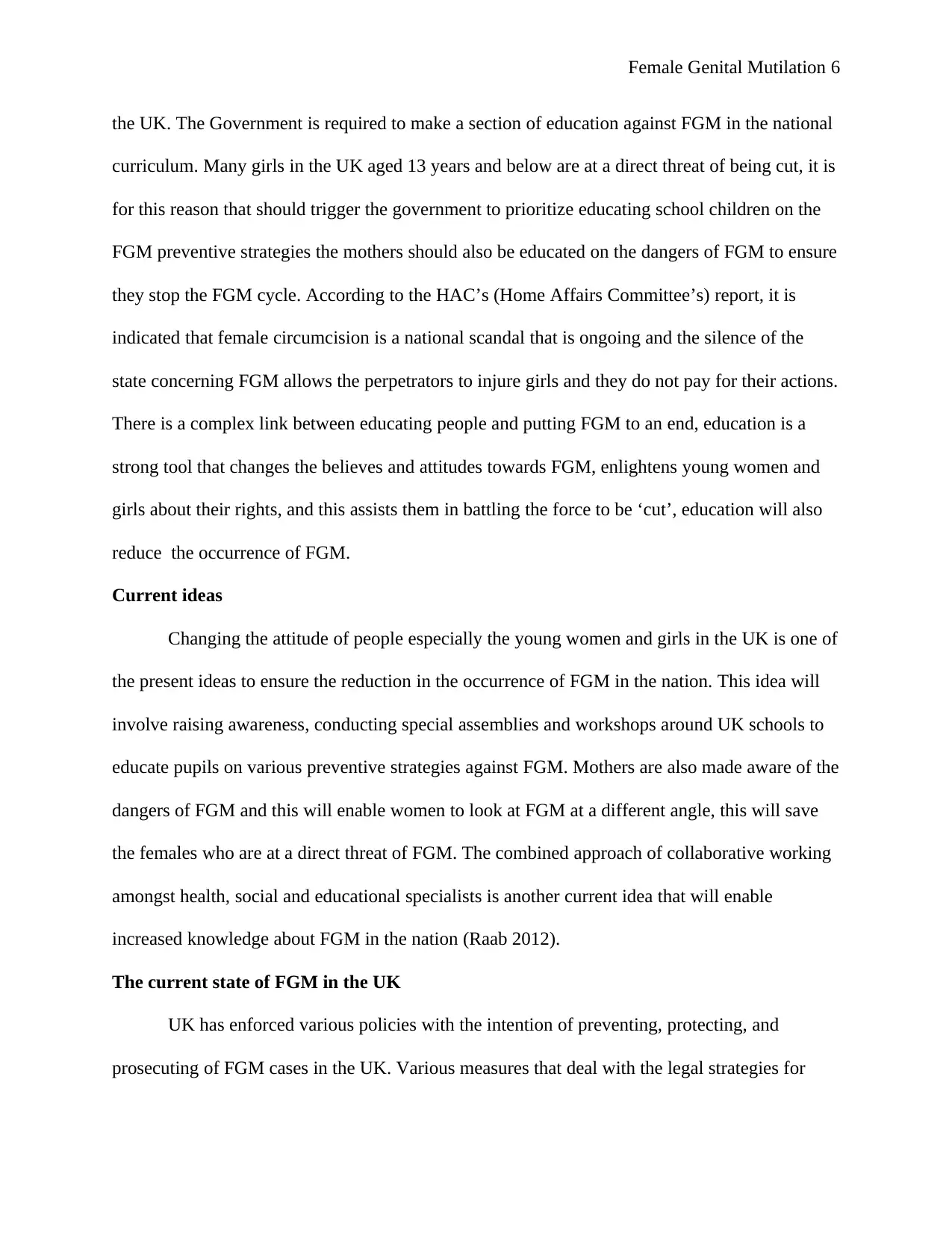
Female Genital Mutilation 6
the UK. The Government is required to make a section of education against FGM in the national
curriculum. Many girls in the UK aged 13 years and below are at a direct threat of being cut, it is
for this reason that should trigger the government to prioritize educating school children on the
FGM preventive strategies the mothers should also be educated on the dangers of FGM to ensure
they stop the FGM cycle. According to the HAC’s (Home Affairs Committee’s) report, it is
indicated that female circumcision is a national scandal that is ongoing and the silence of the
state concerning FGM allows the perpetrators to injure girls and they do not pay for their actions.
There is a complex link between educating people and putting FGM to an end, education is a
strong tool that changes the believes and attitudes towards FGM, enlightens young women and
girls about their rights, and this assists them in battling the force to be ‘cut’, education will also
reduce the occurrence of FGM.
Current ideas
Changing the attitude of people especially the young women and girls in the UK is one of
the present ideas to ensure the reduction in the occurrence of FGM in the nation. This idea will
involve raising awareness, conducting special assemblies and workshops around UK schools to
educate pupils on various preventive strategies against FGM. Mothers are also made aware of the
dangers of FGM and this will enable women to look at FGM at a different angle, this will save
the females who are at a direct threat of FGM. The combined approach of collaborative working
amongst health, social and educational specialists is another current idea that will enable
increased knowledge about FGM in the nation (Raab 2012).
The current state of FGM in the UK
UK has enforced various policies with the intention of preventing, protecting, and
prosecuting of FGM cases in the UK. Various measures that deal with the legal strategies for
the UK. The Government is required to make a section of education against FGM in the national
curriculum. Many girls in the UK aged 13 years and below are at a direct threat of being cut, it is
for this reason that should trigger the government to prioritize educating school children on the
FGM preventive strategies the mothers should also be educated on the dangers of FGM to ensure
they stop the FGM cycle. According to the HAC’s (Home Affairs Committee’s) report, it is
indicated that female circumcision is a national scandal that is ongoing and the silence of the
state concerning FGM allows the perpetrators to injure girls and they do not pay for their actions.
There is a complex link between educating people and putting FGM to an end, education is a
strong tool that changes the believes and attitudes towards FGM, enlightens young women and
girls about their rights, and this assists them in battling the force to be ‘cut’, education will also
reduce the occurrence of FGM.
Current ideas
Changing the attitude of people especially the young women and girls in the UK is one of
the present ideas to ensure the reduction in the occurrence of FGM in the nation. This idea will
involve raising awareness, conducting special assemblies and workshops around UK schools to
educate pupils on various preventive strategies against FGM. Mothers are also made aware of the
dangers of FGM and this will enable women to look at FGM at a different angle, this will save
the females who are at a direct threat of FGM. The combined approach of collaborative working
amongst health, social and educational specialists is another current idea that will enable
increased knowledge about FGM in the nation (Raab 2012).
The current state of FGM in the UK
UK has enforced various policies with the intention of preventing, protecting, and
prosecuting of FGM cases in the UK. Various measures that deal with the legal strategies for
⊘ This is a preview!⊘
Do you want full access?
Subscribe today to unlock all pages.

Trusted by 1+ million students worldwide
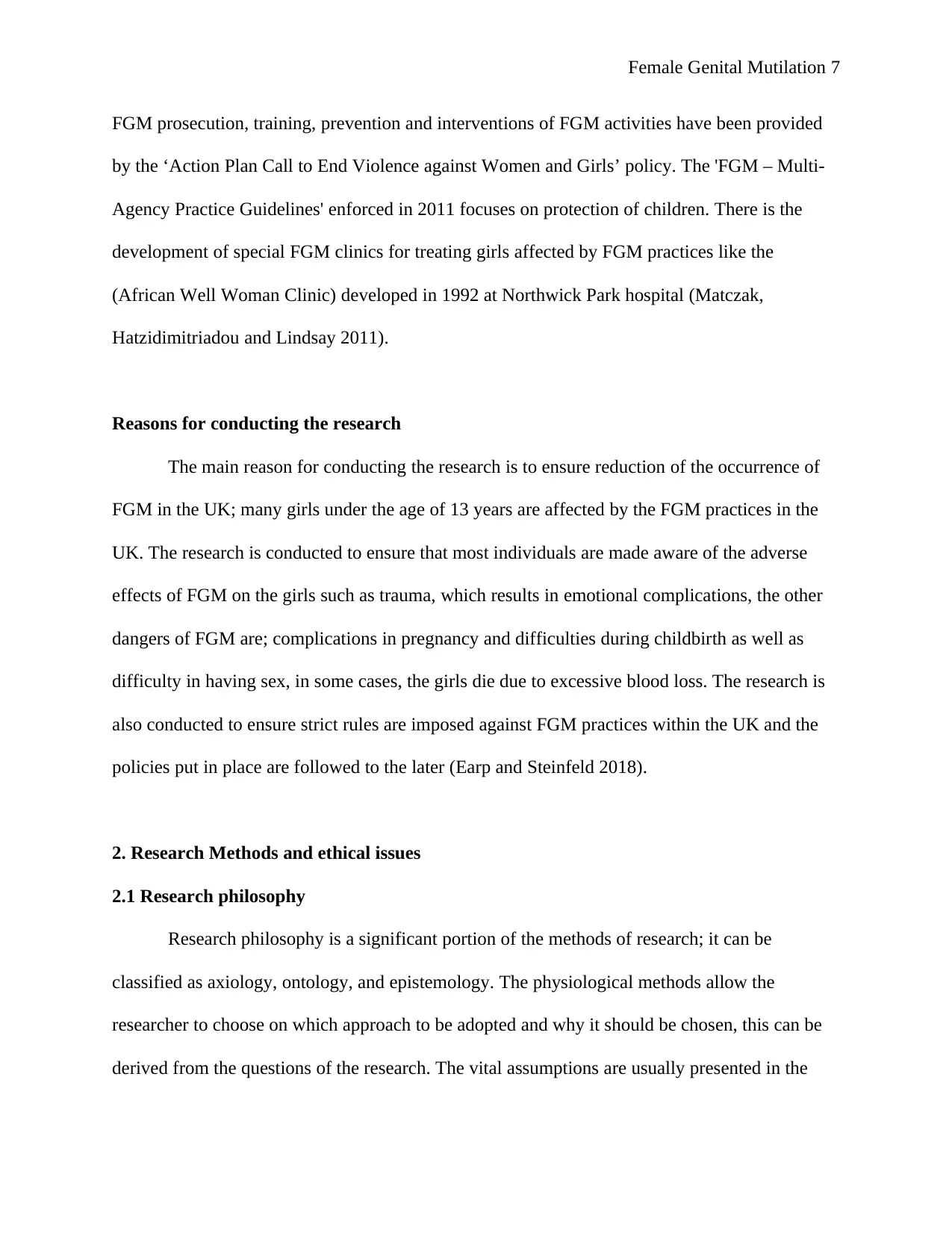
Female Genital Mutilation 7
FGM prosecution, training, prevention and interventions of FGM activities have been provided
by the ‘Action Plan Call to End Violence against Women and Girls’ policy. The 'FGM – Multi-
Agency Practice Guidelines' enforced in 2011 focuses on protection of children. There is the
development of special FGM clinics for treating girls affected by FGM practices like the
(African Well Woman Clinic) developed in 1992 at Northwick Park hospital (Matczak,
Hatzidimitriadou and Lindsay 2011).
Reasons for conducting the research
The main reason for conducting the research is to ensure reduction of the occurrence of
FGM in the UK; many girls under the age of 13 years are affected by the FGM practices in the
UK. The research is conducted to ensure that most individuals are made aware of the adverse
effects of FGM on the girls such as trauma, which results in emotional complications, the other
dangers of FGM are; complications in pregnancy and difficulties during childbirth as well as
difficulty in having sex, in some cases, the girls die due to excessive blood loss. The research is
also conducted to ensure strict rules are imposed against FGM practices within the UK and the
policies put in place are followed to the later (Earp and Steinfeld 2018).
2. Research Methods and ethical issues
2.1 Research philosophy
Research philosophy is a significant portion of the methods of research; it can be
classified as axiology, ontology, and epistemology. The physiological methods allow the
researcher to choose on which approach to be adopted and why it should be chosen, this can be
derived from the questions of the research. The vital assumptions are usually presented in the
FGM prosecution, training, prevention and interventions of FGM activities have been provided
by the ‘Action Plan Call to End Violence against Women and Girls’ policy. The 'FGM – Multi-
Agency Practice Guidelines' enforced in 2011 focuses on protection of children. There is the
development of special FGM clinics for treating girls affected by FGM practices like the
(African Well Woman Clinic) developed in 1992 at Northwick Park hospital (Matczak,
Hatzidimitriadou and Lindsay 2011).
Reasons for conducting the research
The main reason for conducting the research is to ensure reduction of the occurrence of
FGM in the UK; many girls under the age of 13 years are affected by the FGM practices in the
UK. The research is conducted to ensure that most individuals are made aware of the adverse
effects of FGM on the girls such as trauma, which results in emotional complications, the other
dangers of FGM are; complications in pregnancy and difficulties during childbirth as well as
difficulty in having sex, in some cases, the girls die due to excessive blood loss. The research is
also conducted to ensure strict rules are imposed against FGM practices within the UK and the
policies put in place are followed to the later (Earp and Steinfeld 2018).
2. Research Methods and ethical issues
2.1 Research philosophy
Research philosophy is a significant portion of the methods of research; it can be
classified as axiology, ontology, and epistemology. The physiological methods allow the
researcher to choose on which approach to be adopted and why it should be chosen, this can be
derived from the questions of the research. The vital assumptions are usually presented in the
Paraphrase This Document
Need a fresh take? Get an instant paraphrase of this document with our AI Paraphraser
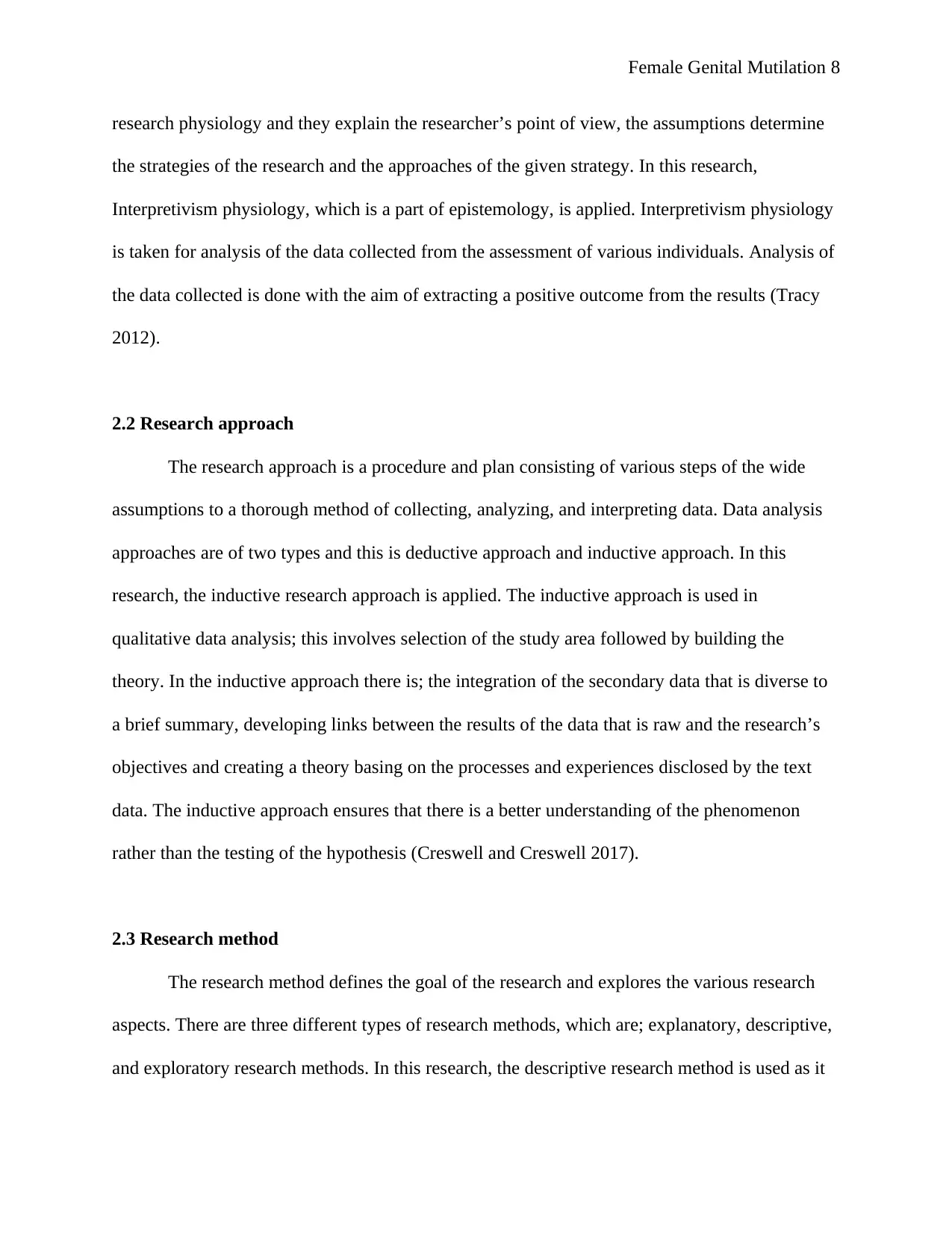
Female Genital Mutilation 8
research physiology and they explain the researcher’s point of view, the assumptions determine
the strategies of the research and the approaches of the given strategy. In this research,
Interpretivism physiology, which is a part of epistemology, is applied. Interpretivism physiology
is taken for analysis of the data collected from the assessment of various individuals. Analysis of
the data collected is done with the aim of extracting a positive outcome from the results (Tracy
2012).
2.2 Research approach
The research approach is a procedure and plan consisting of various steps of the wide
assumptions to a thorough method of collecting, analyzing, and interpreting data. Data analysis
approaches are of two types and this is deductive approach and inductive approach. In this
research, the inductive research approach is applied. The inductive approach is used in
qualitative data analysis; this involves selection of the study area followed by building the
theory. In the inductive approach there is; the integration of the secondary data that is diverse to
a brief summary, developing links between the results of the data that is raw and the research’s
objectives and creating a theory basing on the processes and experiences disclosed by the text
data. The inductive approach ensures that there is a better understanding of the phenomenon
rather than the testing of the hypothesis (Creswell and Creswell 2017).
2.3 Research method
The research method defines the goal of the research and explores the various research
aspects. There are three different types of research methods, which are; explanatory, descriptive,
and exploratory research methods. In this research, the descriptive research method is used as it
research physiology and they explain the researcher’s point of view, the assumptions determine
the strategies of the research and the approaches of the given strategy. In this research,
Interpretivism physiology, which is a part of epistemology, is applied. Interpretivism physiology
is taken for analysis of the data collected from the assessment of various individuals. Analysis of
the data collected is done with the aim of extracting a positive outcome from the results (Tracy
2012).
2.2 Research approach
The research approach is a procedure and plan consisting of various steps of the wide
assumptions to a thorough method of collecting, analyzing, and interpreting data. Data analysis
approaches are of two types and this is deductive approach and inductive approach. In this
research, the inductive research approach is applied. The inductive approach is used in
qualitative data analysis; this involves selection of the study area followed by building the
theory. In the inductive approach there is; the integration of the secondary data that is diverse to
a brief summary, developing links between the results of the data that is raw and the research’s
objectives and creating a theory basing on the processes and experiences disclosed by the text
data. The inductive approach ensures that there is a better understanding of the phenomenon
rather than the testing of the hypothesis (Creswell and Creswell 2017).
2.3 Research method
The research method defines the goal of the research and explores the various research
aspects. There are three different types of research methods, which are; explanatory, descriptive,
and exploratory research methods. In this research, the descriptive research method is used as it
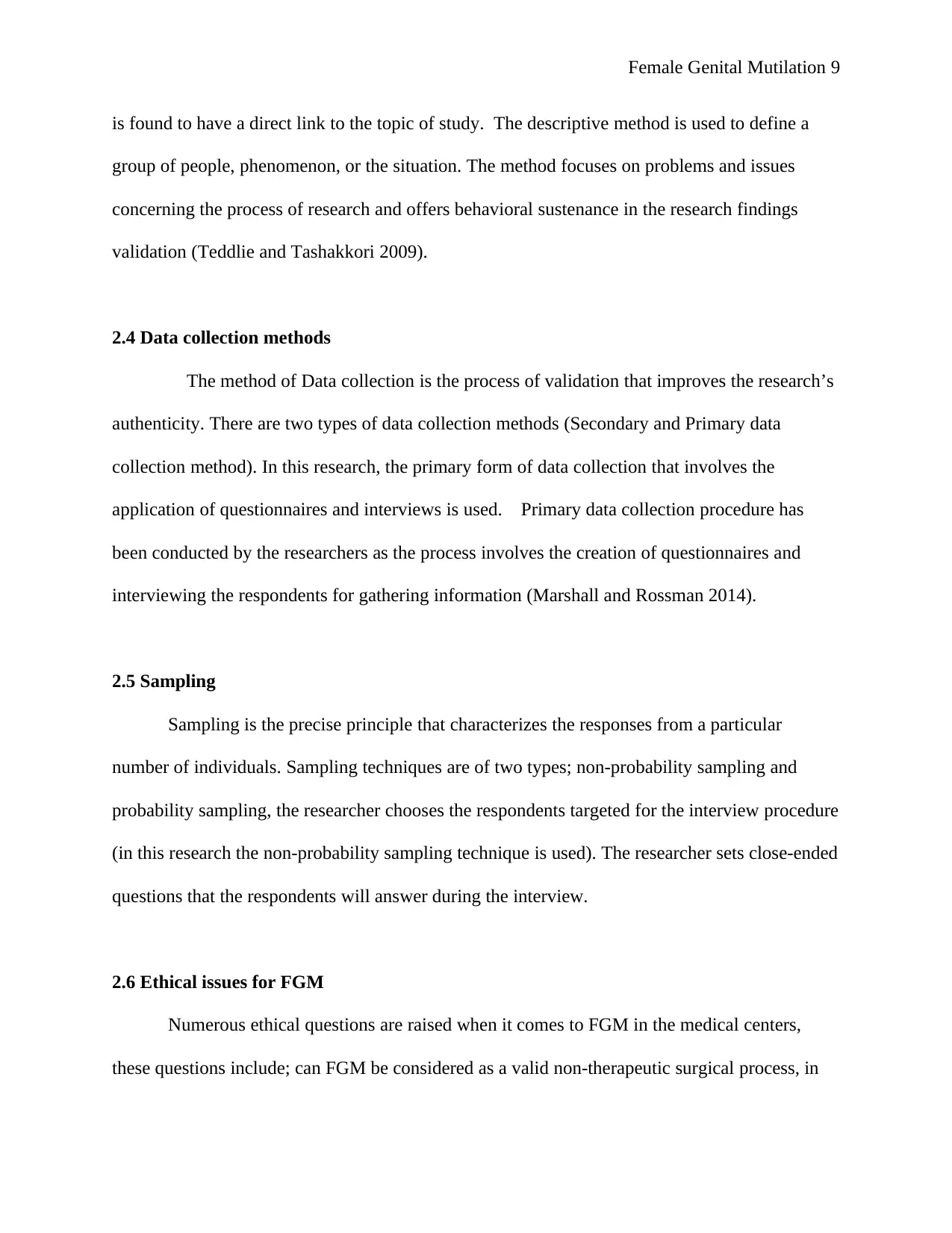
Female Genital Mutilation 9
is found to have a direct link to the topic of study. The descriptive method is used to define a
group of people, phenomenon, or the situation. The method focuses on problems and issues
concerning the process of research and offers behavioral sustenance in the research findings
validation (Teddlie and Tashakkori 2009).
2.4 Data collection methods
The method of Data collection is the process of validation that improves the research’s
authenticity. There are two types of data collection methods (Secondary and Primary data
collection method). In this research, the primary form of data collection that involves the
application of questionnaires and interviews is used. Primary data collection procedure has
been conducted by the researchers as the process involves the creation of questionnaires and
interviewing the respondents for gathering information (Marshall and Rossman 2014).
2.5 Sampling
Sampling is the precise principle that characterizes the responses from a particular
number of individuals. Sampling techniques are of two types; non-probability sampling and
probability sampling, the researcher chooses the respondents targeted for the interview procedure
(in this research the non-probability sampling technique is used). The researcher sets close-ended
questions that the respondents will answer during the interview.
2.6 Ethical issues for FGM
Numerous ethical questions are raised when it comes to FGM in the medical centers,
these questions include; can FGM be considered as a valid non-therapeutic surgical process, in
is found to have a direct link to the topic of study. The descriptive method is used to define a
group of people, phenomenon, or the situation. The method focuses on problems and issues
concerning the process of research and offers behavioral sustenance in the research findings
validation (Teddlie and Tashakkori 2009).
2.4 Data collection methods
The method of Data collection is the process of validation that improves the research’s
authenticity. There are two types of data collection methods (Secondary and Primary data
collection method). In this research, the primary form of data collection that involves the
application of questionnaires and interviews is used. Primary data collection procedure has
been conducted by the researchers as the process involves the creation of questionnaires and
interviewing the respondents for gathering information (Marshall and Rossman 2014).
2.5 Sampling
Sampling is the precise principle that characterizes the responses from a particular
number of individuals. Sampling techniques are of two types; non-probability sampling and
probability sampling, the researcher chooses the respondents targeted for the interview procedure
(in this research the non-probability sampling technique is used). The researcher sets close-ended
questions that the respondents will answer during the interview.
2.6 Ethical issues for FGM
Numerous ethical questions are raised when it comes to FGM in the medical centers,
these questions include; can FGM be considered as a valid non-therapeutic surgical process, in
⊘ This is a preview!⊘
Do you want full access?
Subscribe today to unlock all pages.

Trusted by 1+ million students worldwide
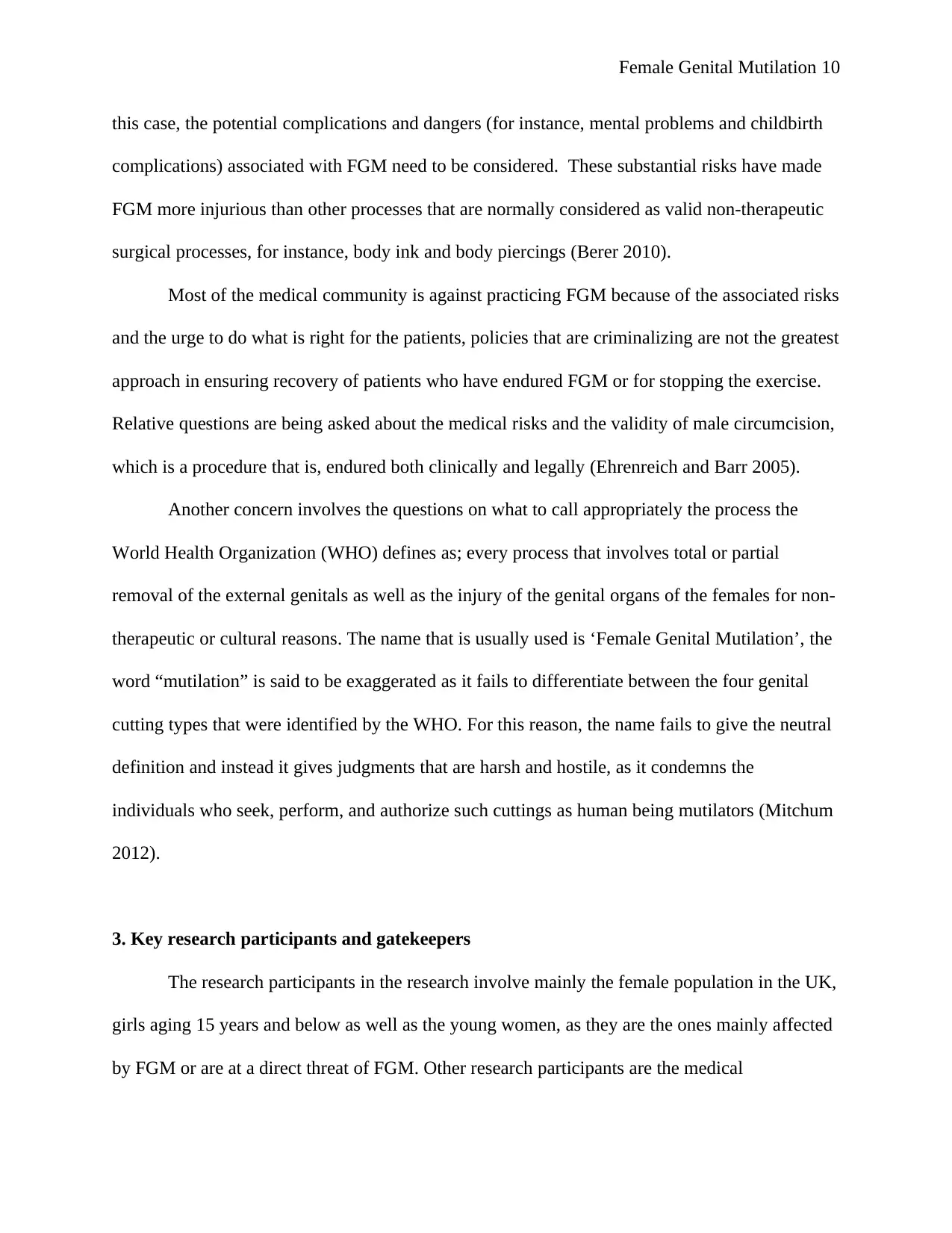
Female Genital Mutilation 10
this case, the potential complications and dangers (for instance, mental problems and childbirth
complications) associated with FGM need to be considered. These substantial risks have made
FGM more injurious than other processes that are normally considered as valid non-therapeutic
surgical processes, for instance, body ink and body piercings (Berer 2010).
Most of the medical community is against practicing FGM because of the associated risks
and the urge to do what is right for the patients, policies that are criminalizing are not the greatest
approach in ensuring recovery of patients who have endured FGM or for stopping the exercise.
Relative questions are being asked about the medical risks and the validity of male circumcision,
which is a procedure that is, endured both clinically and legally (Ehrenreich and Barr 2005).
Another concern involves the questions on what to call appropriately the process the
World Health Organization (WHO) defines as; every process that involves total or partial
removal of the external genitals as well as the injury of the genital organs of the females for non-
therapeutic or cultural reasons. The name that is usually used is ‘Female Genital Mutilation’, the
word “mutilation” is said to be exaggerated as it fails to differentiate between the four genital
cutting types that were identified by the WHO. For this reason, the name fails to give the neutral
definition and instead it gives judgments that are harsh and hostile, as it condemns the
individuals who seek, perform, and authorize such cuttings as human being mutilators (Mitchum
2012).
3. Key research participants and gatekeepers
The research participants in the research involve mainly the female population in the UK,
girls aging 15 years and below as well as the young women, as they are the ones mainly affected
by FGM or are at a direct threat of FGM. Other research participants are the medical
this case, the potential complications and dangers (for instance, mental problems and childbirth
complications) associated with FGM need to be considered. These substantial risks have made
FGM more injurious than other processes that are normally considered as valid non-therapeutic
surgical processes, for instance, body ink and body piercings (Berer 2010).
Most of the medical community is against practicing FGM because of the associated risks
and the urge to do what is right for the patients, policies that are criminalizing are not the greatest
approach in ensuring recovery of patients who have endured FGM or for stopping the exercise.
Relative questions are being asked about the medical risks and the validity of male circumcision,
which is a procedure that is, endured both clinically and legally (Ehrenreich and Barr 2005).
Another concern involves the questions on what to call appropriately the process the
World Health Organization (WHO) defines as; every process that involves total or partial
removal of the external genitals as well as the injury of the genital organs of the females for non-
therapeutic or cultural reasons. The name that is usually used is ‘Female Genital Mutilation’, the
word “mutilation” is said to be exaggerated as it fails to differentiate between the four genital
cutting types that were identified by the WHO. For this reason, the name fails to give the neutral
definition and instead it gives judgments that are harsh and hostile, as it condemns the
individuals who seek, perform, and authorize such cuttings as human being mutilators (Mitchum
2012).
3. Key research participants and gatekeepers
The research participants in the research involve mainly the female population in the UK,
girls aging 15 years and below as well as the young women, as they are the ones mainly affected
by FGM or are at a direct threat of FGM. Other research participants are the medical
Paraphrase This Document
Need a fresh take? Get an instant paraphrase of this document with our AI Paraphraser
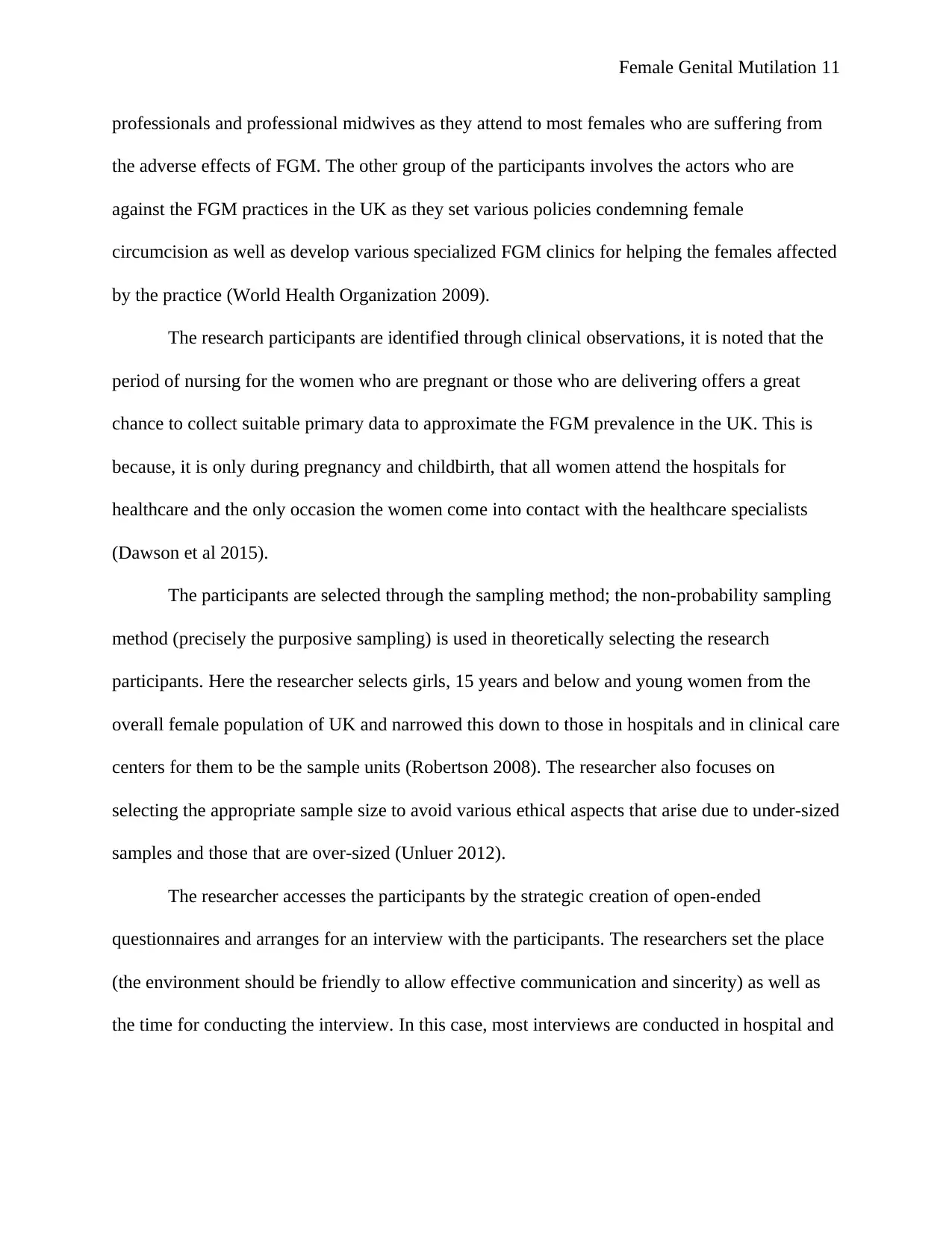
Female Genital Mutilation 11
professionals and professional midwives as they attend to most females who are suffering from
the adverse effects of FGM. The other group of the participants involves the actors who are
against the FGM practices in the UK as they set various policies condemning female
circumcision as well as develop various specialized FGM clinics for helping the females affected
by the practice (World Health Organization 2009).
The research participants are identified through clinical observations, it is noted that the
period of nursing for the women who are pregnant or those who are delivering offers a great
chance to collect suitable primary data to approximate the FGM prevalence in the UK. This is
because, it is only during pregnancy and childbirth, that all women attend the hospitals for
healthcare and the only occasion the women come into contact with the healthcare specialists
(Dawson et al 2015).
The participants are selected through the sampling method; the non-probability sampling
method (precisely the purposive sampling) is used in theoretically selecting the research
participants. Here the researcher selects girls, 15 years and below and young women from the
overall female population of UK and narrowed this down to those in hospitals and in clinical care
centers for them to be the sample units (Robertson 2008). The researcher also focuses on
selecting the appropriate sample size to avoid various ethical aspects that arise due to under-sized
samples and those that are over-sized (Unluer 2012).
The researcher accesses the participants by the strategic creation of open-ended
questionnaires and arranges for an interview with the participants. The researchers set the place
(the environment should be friendly to allow effective communication and sincerity) as well as
the time for conducting the interview. In this case, most interviews are conducted in hospital and
professionals and professional midwives as they attend to most females who are suffering from
the adverse effects of FGM. The other group of the participants involves the actors who are
against the FGM practices in the UK as they set various policies condemning female
circumcision as well as develop various specialized FGM clinics for helping the females affected
by the practice (World Health Organization 2009).
The research participants are identified through clinical observations, it is noted that the
period of nursing for the women who are pregnant or those who are delivering offers a great
chance to collect suitable primary data to approximate the FGM prevalence in the UK. This is
because, it is only during pregnancy and childbirth, that all women attend the hospitals for
healthcare and the only occasion the women come into contact with the healthcare specialists
(Dawson et al 2015).
The participants are selected through the sampling method; the non-probability sampling
method (precisely the purposive sampling) is used in theoretically selecting the research
participants. Here the researcher selects girls, 15 years and below and young women from the
overall female population of UK and narrowed this down to those in hospitals and in clinical care
centers for them to be the sample units (Robertson 2008). The researcher also focuses on
selecting the appropriate sample size to avoid various ethical aspects that arise due to under-sized
samples and those that are over-sized (Unluer 2012).
The researcher accesses the participants by the strategic creation of open-ended
questionnaires and arranges for an interview with the participants. The researchers set the place
(the environment should be friendly to allow effective communication and sincerity) as well as
the time for conducting the interview. In this case, most interviews are conducted in hospital and
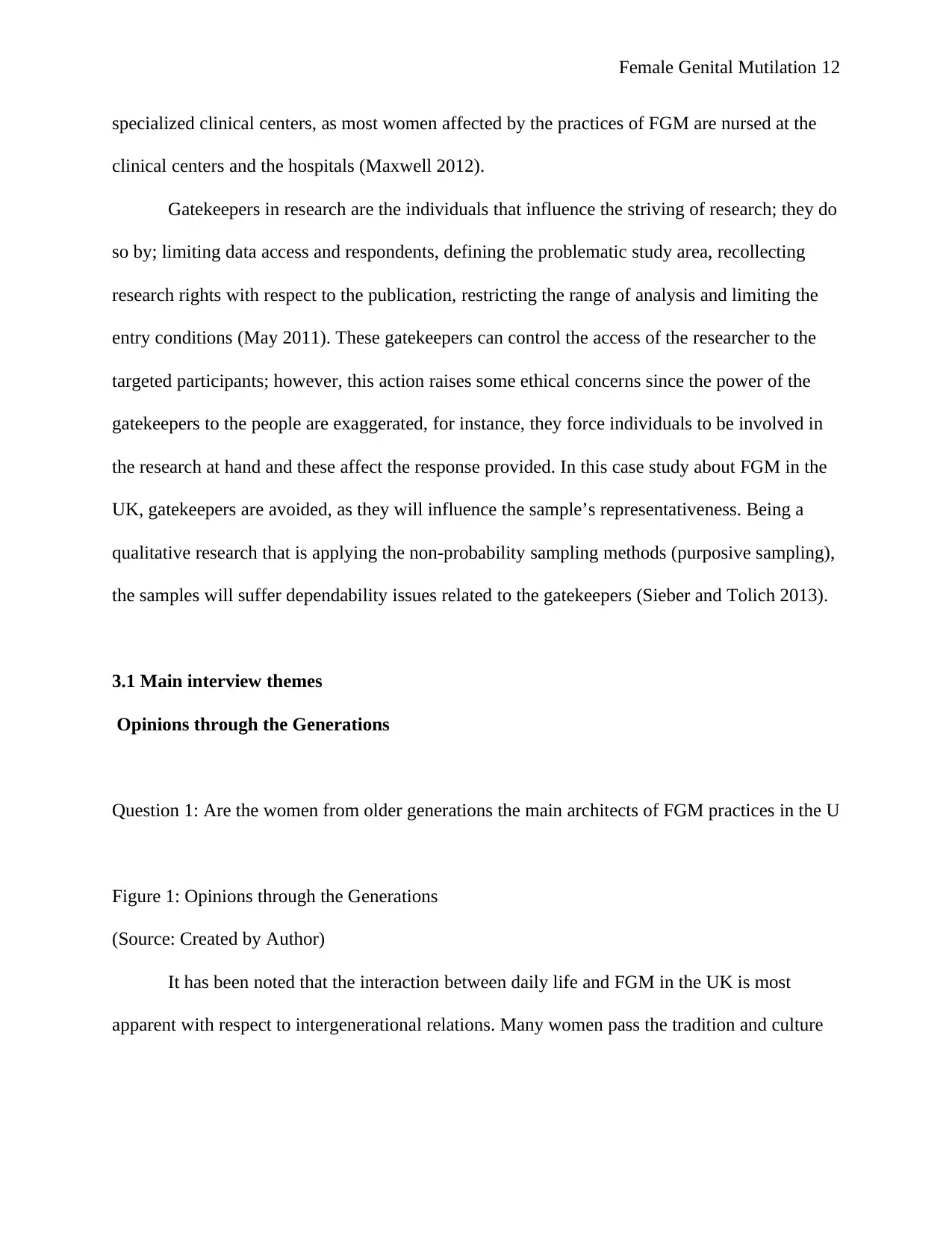
Female Genital Mutilation 12
specialized clinical centers, as most women affected by the practices of FGM are nursed at the
clinical centers and the hospitals (Maxwell 2012).
Gatekeepers in research are the individuals that influence the striving of research; they do
so by; limiting data access and respondents, defining the problematic study area, recollecting
research rights with respect to the publication, restricting the range of analysis and limiting the
entry conditions (May 2011). These gatekeepers can control the access of the researcher to the
targeted participants; however, this action raises some ethical concerns since the power of the
gatekeepers to the people are exaggerated, for instance, they force individuals to be involved in
the research at hand and these affect the response provided. In this case study about FGM in the
UK, gatekeepers are avoided, as they will influence the sample’s representativeness. Being a
qualitative research that is applying the non-probability sampling methods (purposive sampling),
the samples will suffer dependability issues related to the gatekeepers (Sieber and Tolich 2013).
3.1 Main interview themes
Opinions through the Generations
Question 1: Are the women from older generations the main architects of FGM practices in the U
Figure 1: Opinions through the Generations
(Source: Created by Author)
It has been noted that the interaction between daily life and FGM in the UK is most
apparent with respect to intergenerational relations. Many women pass the tradition and culture
specialized clinical centers, as most women affected by the practices of FGM are nursed at the
clinical centers and the hospitals (Maxwell 2012).
Gatekeepers in research are the individuals that influence the striving of research; they do
so by; limiting data access and respondents, defining the problematic study area, recollecting
research rights with respect to the publication, restricting the range of analysis and limiting the
entry conditions (May 2011). These gatekeepers can control the access of the researcher to the
targeted participants; however, this action raises some ethical concerns since the power of the
gatekeepers to the people are exaggerated, for instance, they force individuals to be involved in
the research at hand and these affect the response provided. In this case study about FGM in the
UK, gatekeepers are avoided, as they will influence the sample’s representativeness. Being a
qualitative research that is applying the non-probability sampling methods (purposive sampling),
the samples will suffer dependability issues related to the gatekeepers (Sieber and Tolich 2013).
3.1 Main interview themes
Opinions through the Generations
Question 1: Are the women from older generations the main architects of FGM practices in the U
Figure 1: Opinions through the Generations
(Source: Created by Author)
It has been noted that the interaction between daily life and FGM in the UK is most
apparent with respect to intergenerational relations. Many women pass the tradition and culture
⊘ This is a preview!⊘
Do you want full access?
Subscribe today to unlock all pages.

Trusted by 1+ million students worldwide
1 out of 23
Related Documents
Your All-in-One AI-Powered Toolkit for Academic Success.
+13062052269
info@desklib.com
Available 24*7 on WhatsApp / Email
![[object Object]](/_next/static/media/star-bottom.7253800d.svg)
Unlock your academic potential
Copyright © 2020–2025 A2Z Services. All Rights Reserved. Developed and managed by ZUCOL.





